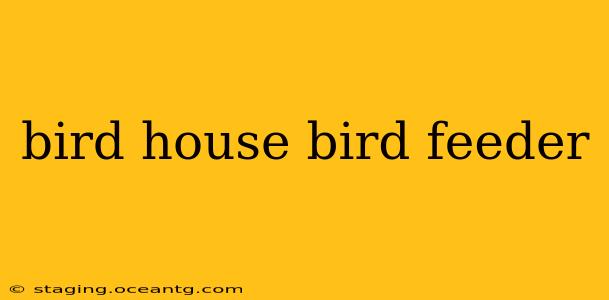Attracting birds to your backyard is a rewarding experience, offering hours of entertainment and a connection with nature. Two popular methods for achieving this are installing a birdhouse and setting up a bird feeder. But which is best for you, and what are the key differences? This comprehensive guide will explore the nuances of bird houses and feeders, helping you make an informed decision to best suit your needs and the local avian population.
What's the Difference Between a Birdhouse and a Bird Feeder?
The core difference lies in their function: birdhouses provide shelter and nesting sites, while bird feeders supply food. Birdhouses are primarily for raising young, offering protection from predators and the elements. Bird feeders, conversely, are designed to attract birds by providing a readily available source of sustenance. While both attract birds, they cater to different aspects of their needs.
What Kind of Birds Use Birdhouses?
Many species utilize birdhouses for nesting, but the type of birdhouse will determine which species are most likely to utilize it. Factors like size, entry hole diameter, and location are crucial. For instance:
- Smaller birdhouses with smaller entry holes (1.25 inches) attract chickadees, wrens, and bluebirds.
- Larger birdhouses with larger entry holes (1.5 inches or more) might attract robins, woodpeckers, or larger species.
It's essential to research the common birds in your area and select a birdhouse appropriately sized for their nesting needs.
What Kind of Birds Use Bird Feeders?
The type of bird feeder directly impacts which birds are attracted. Different feeders cater to different feeding styles:
- Tube feeders are popular with smaller birds like finches and hummingbirds.
- Hopper feeders attract a wider variety of birds, including cardinals, jays, and sparrows.
- Suet feeders are a favorite among woodpeckers, nuthatches, and chickadees.
Offering a variety of feeders and seed types will increase the diversity of birds you attract.
Do I Need Both a Birdhouse and a Bird Feeder?
This depends on your goals and the birds in your area. If your primary aim is to simply attract birds for observation, a bird feeder might suffice. However, if you want to encourage breeding and nesting, a birdhouse is essential. Many bird enthusiasts find that having both a birdhouse and a feeder creates a more comprehensive and attractive habitat, increasing the likelihood of attracting a wider variety of species and supporting their life cycles.
How Often Should I Clean My Birdhouse?
Cleaning your birdhouse is crucial for preventing the spread of diseases and parasites. It's generally recommended to clean it thoroughly after nesting season (typically fall). Remove all nesting material and scrub the interior with a mild disinfectant solution. Allow it to dry completely before reinstalling it.
How Often Should I Clean My Bird Feeder?
Bird feeders require regular cleaning to prevent the buildup of mold, mildew, and bacteria. Clean your feeder at least once a month, or more frequently during warm, humid weather. Remove old, spoiled seed and scrub the feeder with soapy water. Rinse thoroughly and allow it to dry completely before refilling.
Where Should I Place My Birdhouse?
Location is critical for birdhouse success. Consider these factors:
- Predator protection: Place the birdhouse away from easily accessible branches or other perches where predators might be able to reach it.
- Shelter from the elements: Choose a location that offers some protection from rain and wind.
- Adequate sunlight: Ensure the birdhouse receives some sunlight but avoid areas of direct, intense heat.
Where Should I Place My Bird Feeder?
Similar to birdhouses, feeder placement is important:
- Predator protection: Keep the feeder away from bushes or trees that provide cover for cats or other predators.
- Easy access: Position the feeder where you can easily observe the birds but still provide them with a sense of security.
- Accessibility for cleaning: Choose a location that's easily accessible for regular cleaning and refilling.
By understanding the differences and considering these factors, you can create a welcoming and vibrant habitat that attracts a diverse range of beautiful birds to your backyard. Remember, responsible bird feeding and housing practices are key to ensuring their health and well-being.
